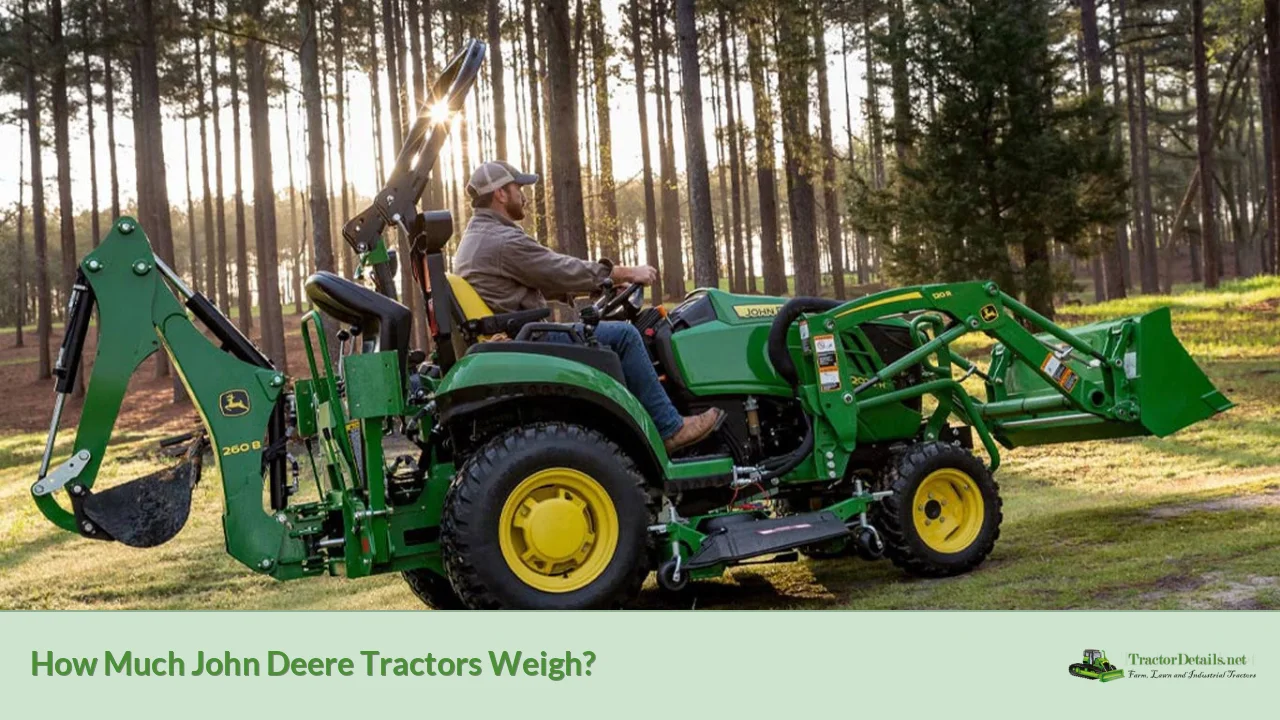John Deere tractors are renowned for their durability, performance, and versatility in various agricultural and industrial applications. The weight of these tractors varies significantly based on the model, configuration, and intended use. Understanding the weight of John Deere tractors is essential for farmers and operators as it affects transport logistics, stability during operation, and compatibility with attachments.
The weight of John Deere tractors can range from light utility models to heavy-duty agricultural machines. For instance, smaller utility tractors may weigh around 1,900 kg (4,189 lbs), while larger models can exceed 8,000 kg (17,600 lbs) when fully equipped. This variance is influenced by factors such as engine size, transmission type, and additional features like cabs or ballasting.
Here’s a brief overview of some John Deere tractor models and their corresponding weights:
| Model | Weight (kg) |
|---|---|
| John Deere 2320 | 753 kg |
| John Deere 5055D | 1,900 to 2,116 kg |
| John Deere 6110B | 4,830 kg |
| John Deere 6R Series | 5,200 to 8,000 kg |
Overview of John Deere Tractor Weight Categories
The weight categories of John Deere tractors can be broadly classified into three main groups: compact, utility, and heavy-duty tractors. Each category serves different purposes and has distinct weight characteristics.
Compact Tractors
Compact tractors are designed for small-scale farming and landscaping tasks. They are lightweight and easy to maneuver in tight spaces. Their weights typically range from:
- 500 kg to 1,500 kg (1,100 lbs to 3,300 lbs)
These tractors are ideal for homeowners or small farm operators who require a versatile machine for tasks like mowing or light tillage.
Utility Tractors
Utility tractors are more robust than compact models and are suitable for a variety of agricultural tasks. They usually weigh between:
- 1,500 kg to 3,500 kg (3,300 lbs to 7,700 lbs)
This category includes models like the John Deere 5055D and the John Deere 6B series. These tractors offer a balance of power and maneuverability for medium-sized farms.
Heavy-Duty Tractors
Heavy-duty tractors are built for large-scale agricultural operations. They can handle substantial loads and often have features designed for high performance in demanding environments. Their weights can exceed:
- 3,500 kg up to over 8,000 kg (7,700 lbs to over 17,600 lbs)
Models such as the John Deere 6R series fall into this category. These tractors are equipped with powerful engines and advanced technology to optimize productivity.
Factors Influencing Tractor Weight
Several factors influence the weight of John Deere tractors beyond their category classification. Understanding these factors can help users select the right model for their needs.
Engine Size
The engine size directly correlates with the tractor's weight. Larger engines typically add more weight due to their construction materials and components. For example:
- A tractor with a 55 hp engine might weigh around 2,000 kg, while a 200 hp engine could push the weight over 8,000 kg.
Transmission Type
The type of transmission also contributes to the overall weight. Tractors with more complex transmission systems tend to be heavier due to additional components required for operation.
Cab Configuration
Tractors equipped with cabs for operator comfort will generally weigh more than open-station models. The added structure for climate control and safety features increases the overall mass significantly.
Ballasting
Ballasting is often used to enhance traction on heavy-duty tractors. Operators may add weights or use heavier tires to improve stability in challenging conditions. This practice can increase the operational weight by several hundred kilograms.
Popular John Deere Tractor Models and Their Weights
To provide a clearer picture of how much specific John Deere tractor models weigh, here's a detailed list featuring some popular choices:
| Model | Weight (kg) |
|---|---|
| John Deere 2320 | 753 kg |
| John Deere 5055D | 1,900 - 2,116 kg |
| John Deere 6110B | 4,830 kg |
| John Deere 6195R | 8,000 kg |
These examples illustrate the diversity in weight across different models tailored for various agricultural needs.
Importance of Understanding Tractor Weight
Understanding tractor weight is crucial for several reasons:
Transport Logistics
Knowing the weight of a tractor is essential when planning transportation. Overweight vehicles can lead to fines or damage during transport. Proper knowledge ensures compliance with road regulations.
Stability During Operation
Heavier tractors tend to have better stability when operating on uneven terrain or during heavy lifting tasks. This stability reduces the risk of accidents or tipping over during operation.
Compatibility with Attachments
Different attachments have specific weight limits that must be adhered to for safe operation. Understanding your tractor's weight helps ensure that it can handle additional loads without compromising performance or safety.
FAQs About How Much John Deere Tractors Weigh
- What is the average weight of a John Deere tractor?
The average weight ranges from about 1,900 kg for smaller models up to over 8,000 kg for larger ones. - How does engine size affect tractor weight?
Larger engines typically increase the overall weight due to their construction materials. - Are heavier tractors better for stability?
Yes, heavier tractors generally provide better stability on uneven terrain. - Can I add ballast to my tractor?
Yes, adding ballast can improve traction but will also increase operational weight. - Do cab configurations affect tractor weight?
Yes, cabs add extra weight compared to open-station models.
In conclusion, understanding how much John Deere tractors weigh is vital for selecting the right model based on operational needs and conditions. The variety in weights across different categories allows users to choose machines that best fit their requirements while ensuring safety and efficiency in agricultural practices.
